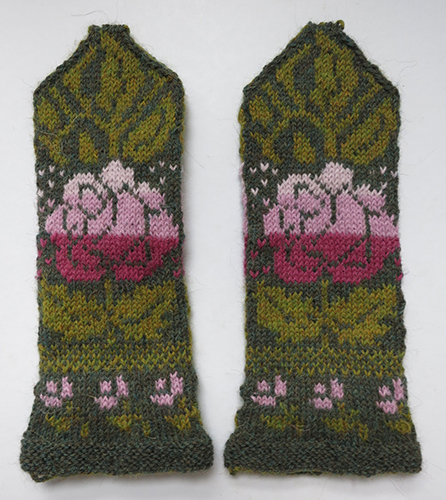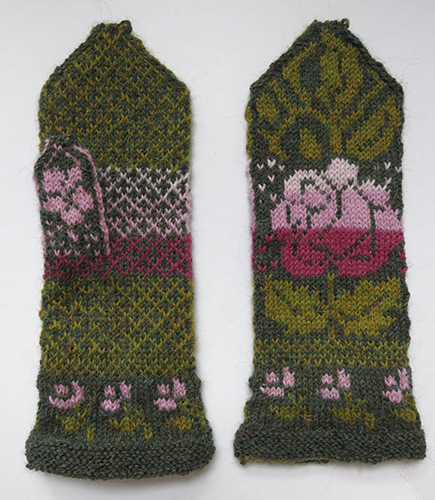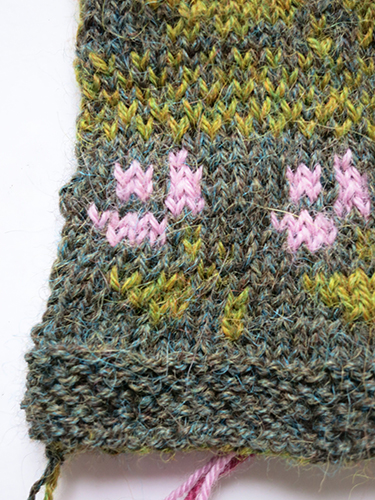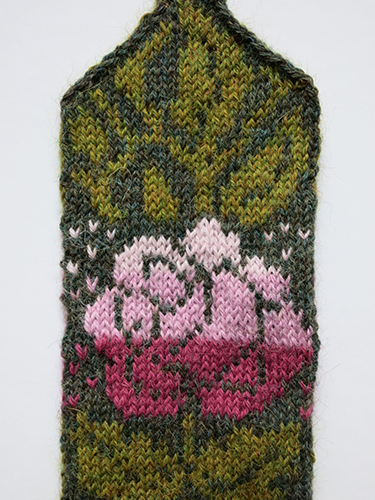Either Or is not just the title of Februarys second mitten but also that of a very well known philosophical work. Either Or was written by Soren Kierkegaard a Danish philosopher of great importance. It consist of two volumes Either and Or (Enten-Eller in Danish).
This book had a special place in my childhood home as my father is an academic in the field of religious philosophy, he works in particular with German philosopher Schleiermacher and with Kierkegaard.

Either Or Mitten. Pattern by Lee Meredith of leethalknits. Knit by Anne Grove.
The pattern is written by Lee Meridith of leethalknits. She makes wonderfully whimsy patterns that make great projects for homespun and art yarns. She is good at explaining the techniques used which is really great for this pattern. It looks very difficult but it is simpler than that!
The pdf contains patterns for three different Either Or mittens. The short fingerless, the long fingerless and the mitten. This pattern is shaped around your hand as you knit, which means you need to size it on your hand. I am doing the long fingerless. As it was the pair that I fell in love with and it’s most versatile. Also very important it fits several sizes easier and as I have tiny hands I need not to fit them too much to my self.

Either Or mitten. Pattern and picture by Lee Meredith, of Leethalknits.
This week has been a bit different from the other weeks. Which will also show in this blogpost. This pattern isn’t just ‘plug and play’ it’s a 28 pages long pdf. Which is pretty daunting! It is very well made and it’s great to look at but it is a bit confusing the first time you read it. I want to make it clear I can’t see how this pattern should be any shorter than the 28 pages. Just make sure to read it a couple of times before starting your project and have in mind that sometimes patterns doesn’t make sense before you just knit it.
One tip I can give is to follow the directions and don’t question them (I’m really good at that!) then it all makes sense. It’s a bit like knitting heels on socks for the first time. Don’t think, just do it.
This mitten differs from regular mittens as it’s knit from the thumb and out, working around the hand. When your work is large enough to fold around your hand you gather and work back and forth and “seem” the mitten up.
This technique confused me at first as it’s not until you get quite far down in the pattern you can see directions for sizes. I at least need directions for sizes as I have tiny hands and knitting for this project I need mittens not to be my size all of them as most of you wouldn’t be able to fit them afterwards.

On the test mitten I tried a little of it all. I did the stripes, I did the garter stitch wrist and I did the stockinette stitch wrist. I ought to knit another one so there is a pair, don’t I?
What I did was to knit a test mitten. To learn the pattern. To see how the different wrist/hand parts would look. I chose to knit the mitten in a soft store bought alpaca that already had a gauge guide on the wrapper to take that part out of this first calculation. Also I did the mitten in two different colors to test out that part of the pattern.
I originally thought I would do that with the final mitten as well but I changed my mind after I looked in my yarn stash. I wanted to use handspun yarn for this project as it’s in the spirit of Leethalknits but also because this patterns really can showcase the yarn.
I found an amazing wool blend. What it is I don’t know for sure as it didn’t have a label on it. Also I had to go look deep in the craftster logs to find out who made it. I got it in a swap a while back and it truely is amazing. I love earthy colors combined with turquoise. The woman behind this yarn is nicknamed Bugaboo1 – her real name is Stephanie Woolever (preeeetty perfect for a spinner if you ask me!).

The mittens are different from each other because of the handspun yarn. You can see differences from mitten to mitten as well as on the two sides of the mitten.
WPI-method
WPI is short for wraps per inch. As simple as it is, you wrap your yarn around a ruler or a knitting needle and count how many wraps there is per inch. Use this method to help you determine what size needle you need for your handspun yarn (or a skein that lost its band).
For this pattern I would recommend not using a yarn that has super bulky parts as well as fingering parts. But using a yarn that varies is not a problem as you can see on the picture with the three types of mittens. Have in mind if you knit with varied thickness yarn that this might effect the row count for the thumb of this pattern.
Try to find an average, if the wraps per inch count is an uneven number use the highest number. That way you allow the thick yarn not to end up being knit too tight. What happens when your textile is knit very tight is that it get stiffer and can seem a little coarser.
This part a compilation of what you need for this pattern. To find chart and read more on the WPI-method see my post here.

The unblocked Either Or Mitten twists and turns a bit. The different knit directions and the change in stockinette and garter stitch makes it twist.
I would recommend Meredith to try to revise her pattern. Not because it’s missing anything as such. But I think that a different way of organizing it could help immensely on the difficulty level. It seems completely impossible to get an overview to begin with and it was only when I had done the third mitten I could maneuver around in the 28 pages long pdf with confidence.
It would probably make an even longer pdf, but it would make a big difference if she had chosen to gather the pattern for respectively short fingerless, long fingerless and full mitten each in their segment. It is extremely confusing in an already confusing pattern to have to scroll back and forth (/jump from page to page – if printet). I think that such a change would render the pattern much more comprehendible and thus easier to use.
I do however like the last 6 pages that is made to print only the pattern without the pictures. However I needed the pictures to understand what she wrote on the first and a little in the second mitten. So I was dependent on the full pdf throughout most of this project.
Notes & thoughts
1. Do a test mitten! The first mitten takes AGES to do as you try to find your way through a lot of numbers and abbreviations. In danish we have a saying that directly translated is “to keep your tong straight in your mouth” (At holde tungen lige i munden). You need to focus a lot to understand this – the first time.
Already when you knit the first mitten of the pair (the second, counting the tester) you will find that it’s much much easier. And the third – well that’s just like any other easy to regular difficulty leveled pattern.
2. Thumb: You count how many rows you knit for the thumb and you write it down, according to the guide. But have in mind if you are knitting in a homespun yarn that varies a lot that this count might not be the same.

3. I would recommend doing notes when knitting this pattern. It helped me a lot. Just a little pad to note down on next to your pattern. If you print the pattern you have boxes to put on little counts but I like to have them on one page compared to a minimum of 4-6 pages of the pattern. Personally I prefer to have it all on one pad so I have all the notes on one page.
4. Use different colored or sized markers! All 7 of them – otherwise it can get really difficult to follow the pattern. I used:
mA blue, big (beginning of round)
mB1 white
mB2 red
mC1 purple
mC2 light red, big
mD1 blue, small
mD2 light red, small
It was a huge help to me that I noted down what markers had which colors. Working with 7 markers I needed to be able to color code them to make sure I didn’t loose my way during the pattern.
5. If you are doing a mitten for someone else (= a different handsize than yourself) go to page 12 to read what to do. If you follow the pattern slavish don’t think about this, but if you like me like to know a little about sizing before you start, you will find the information on page 12, last section.
A little tip: When you are doing a project that is very complicated have a super easy project to work on as well. Sometimes you just need to knit. Sometimes you need to see progress and that can be hard to see in a project that is very intricate and needs a lot of focus on the technical side. This helps me keep up the spirit and joy of knitting while attempting new challenges.
Edit: For this project I did the Mittenz by Mariella Apodaca.
Despite all the hardship I would enjoy to make more of these mittens. It’s a joy to knit when you get the hang of it and it’s a perfect project to showcase amazing yarns! And who doesn’t need a good excuse to buy amazing yarn – now that you have a pattern to use it with? 😉







































